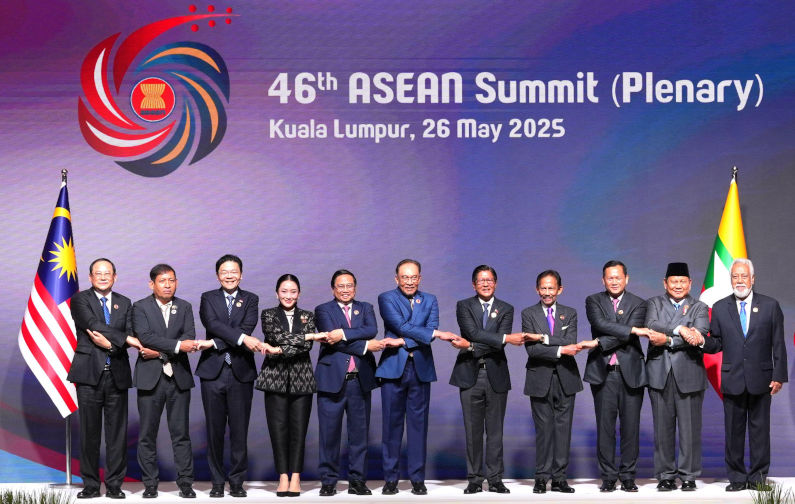Malaysia keeps fractious ASEAN family together
June 3, 2025
Kudos to Malaysia. Putrajaya has just finished hosting the 46th ASEAN summit in Kuala Lumpur over six days. Judging from the attendance, statements and declarations, the summit was a great success.
The Kuala Lumpur Declaration is a testimony of their continued commitment to regional co-operation.
Anwar Ibrahim has taken over the 2025 chairmanship with a goal to prioritise expanding trade and investment linkages. That is a daunting task but an important one. Today, intra-ASEAN FDI amounts to less than Japan’s foreign direct investment in Malaysia alone at US$30 billion. Intra- ASEAN trade, which measures the level of willingness to buy and sell products to each other, still hobbles around 22% to 26%.
Similarly, intra-ASEAN investment remains low, about 17%, approximately US$28 billion, of what the member states invest globally. Anwar has yet to enunciate his plans that require full consensus from all ASEAN member states. This legacy of arriving at decision-making through the process of consultation — an idea borrowed from customary practices in Indonesian culture — is worth defending so long as it does not make ASEAN into a mere talking shop.
The relevance of consensus, the hallmark of ASEAN’s esprit de corps, whose relevance in a fluid multilateral environment that demands agility in decision-making, has been tested many times. To their credit, the ASEAN leaders have learnt to work around the consensus mechanism to arrive at a consensual agreement.
The ASEAN way of agreeing to disagree is a face-saving mechanism that has worked well!
Once lauded as a model for regional co-operation, the 10-member group risks becoming irrelevant if it cannot adapt and keep step with new developments in the global order. Singapore’s Prime Minister Lawrence Wong made it quite clear at the summit that “ASEAN faces a moment of truth” unless it makes itself relevant in a changed world.
The region’s future depends on its unity, leadership and adaptability. It also depends on the ability of the organisation to embrace multilateralism and engaging other like-minded parties besides the traditional dialogue partners. Reaching out to the Gulf states is important; engaging the expanded BRICS — first started with Brazil, India, China and South Africa — makes economic sense. Ignoring Russia, Europe, Africa and Latin America would be perilous.
Malaysia has helped chart a path forward – not by clinging to old habits, but by boldly redefining ASEAN’s role in a multipolar era.
ASEAN faces a binary challenge: weathering and managing the geopolitical storms and steadying the ship in choppy internal waters by minimising intra-ASEAN differences and reducing divisiveness.
Arguably the 46th summit’s most important task was to keep the family together. Despite differences, mainly at the bilateral level, for example, between China and the Philippines over the situation in the South China Sea, Anwar was able to keep the family intact.
By reducing the fragmentation into which it has been sliding, pushed by two seemingly insoluble issues, the conflict in Myanmar and dominance of the South China Sea, as chairman, Malaysia was able to keep the ASEAN boat on an even keel, at least for the time being.
The next milestone in regional co-operation is managing the tariffs that President Trump has unilaterally imposed on them. Amidst ongoing bilateral discussions, the calls for co-ordination have fallen on deaf ears.
A broken ASEAN is bad for the region. At the forefront of the new global geopolitical disorder, which has a direct bearing on ASEAN, is the ongoing US-China rivalry. The US, long seen as the region’s security guarantor, is no longer held in high esteem in the region according to recent surveys by ISEAS-Yusoff Ishak Institute, Singapore. While US influence remains on paper, it has been quite erratic in practice. The United States, which long billed itself as the guarantor of regional peace, has upped sticks, while China, whose nine-dash line runs almost onto some countries’ doorsteps, is gaining primacy.
The rivalry has the effect of pulling ASEAN in different directions. It has exacerbated tensions not only with China and the US, but also between the states with overlapping territorial claims in the South China Sea. Unwittingly, these tensions have undermined ASEAN’s ability to exert influence, for example, to manage disputes. By deepening the bilateral tensions, rival powers have succeeded in weakening ASEAN’s centrality. By giving lip service to ASEAN’s centrality, the big powers and allies continue to undermine it.
China, which rattled the US during the recent tariff tiff, has emerged not only as a peer competitor, but as a challenger to the status quo. Many pundits believe China has beaten the US in all sectors from technology to outer space.
Not surprisingly, Pax Americana is listing in turbulent waters.
Given the above, ASEAN cannot remain an always-reactive, passive buffer. Its leaders need to think beyond the US-China rivalry and become an active balancer to dilute the bipolar tensions. As it embraces multilateralism, it must be more citizen-centred and driven more by the private sector.
A weak ASEAN will not bring peace to the region.
The views expressed in this article may or may not reflect those of Pearls and Irritations.
